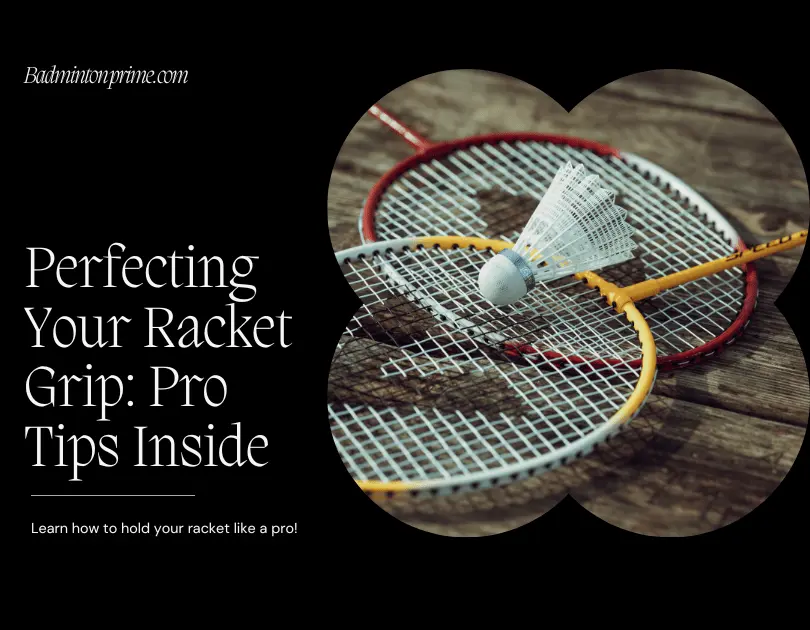So, you’ve decided to step onto the badminton court and give it your all. Congratulations! Before you start smashing shuttlecocks, it’s crucial to master the basics. And it all begins with how you hold your racket. In this guide, we’ll take you through the ins and outs of the proper badminton racket grip, ensuring you start your badminton journey on the right foot—or, should I say, the proper grip.
The Foundation: Understanding Grip Types
Before delving into the nitty-gritty of holding a badminton racket, let’s explore the two primary grip types: the forehand grip and the backhand grip.
Forehand Grip
The forehand grip is the go-to grip for most badminton shots. To achieve this grip, place your hand on the racket handle as if you were shaking hands with it. Ensure that the base knuckle of your index finger rests on the third angle of the racket handle.
Backhand Grip
When it comes to backhand shots, a specialized grip is required. For the backhand grip, rotate your hand counterclockwise on the handle so the base knuckle of your thumb is on the third angle. This grip provides better control for those tricky backhand shots.
Perfecting Your Hold
Now that you’re familiar with the grip types let’s move on to the proper techniques for holding the racket.
Firm, Not Tight
One common mistake beginners make is gripping the racket too tightly. Remember, you want a firm hold, not a death grip. Hold the racket with just enough pressure to maintain control without causing tension in your arm.
Maintain a Relaxed Wrist
Flexibility is key in badminton, and that includes your wrist. Keep your wrist relaxed, allowing for swift and precise movements. A stiff wrist can hinder your ability to execute different shots effectively.
Finding Your Comfort Zone
No two players are the same, and the same goes for their grips. It’s essential to find a grip that feels comfortable and natural for you. Experiment with different grips during practice sessions until you discover the one that complements your playing style.
Adjusting Grip for Different Shots
Versatility is the name of the game in badminton. Learn to adjust your grip based on the type of shot you’re about to play. Whether it’s a powerful smash or a delicate drop shot, having the proper grip is paramount.
Common Mistakes to Avoid
In the pursuit of the perfect grip, it’s easy to fall into some common pitfalls. Let’s identify and address these mistakes to ensure your badminton journey is smooth.
Overlooking Grip Maintenance
Your grip is your connection to the racket. Regularly check for wear and tear and replace it when necessary. A deteriorating grip can affect your control and performance on the court.
Neglecting Hand Position
Pay attention to the position of your hand on the racket handle. Minor adjustments can make a significant difference in your shot accuracy and power.
The Importance of Grip in Game Performance
Now that you’ve honed your grip let’s explore how it directly influences your overall game performance.
Power and Precision
A proper grip lays the foundation for robust and precise shots. It allows you to transfer energy efficiently, resulting in impactful smashes and accurate drop shots.
Defensive Maneuverability
In the fast-paced world of badminton, defence is as crucial as offence. The proper grip enhances your manoeuvrability, enabling quick reflexes and effective defensive play.
Conclusion
Congratulations! You’ve taken the first step toward mastering badminton by learning the art of racket grip. Remember, it’s not just about holding a racket; it’s about finding a grip that becomes an extension of your playing style. As you hit the courts, keep refining your grip and adapting it to different game situations.
For more tips about badminton, check badmintonbay
Frequently Asked Questions (FAQs) and Answers:
How often should I change my badminton racket grip?
Answer: Ideally, every 3-6 months to maintain optimal control and performance.
Can I use the exact grip for forehand and backhand shots?
Answer: While possible, specialized grips enhance control; experiment to find what suits you.
Is there a universal badminton grip that fits all players?
Answer: No, preferences vary based on hand size, style, and comfort; find what works for you.
Should I restring my racket when changing the grip?
Answer: Yes, it’s recommended to restring to ensure optimal performance and responsiveness.
Can a proper grip compensate for a lack of badminton skills?
Answer: A proper grip is crucial, but skill development remains essential for sustained success.
How often should I replace my racket grip?
Answer: It’s advisable to replace your grip every 3-6 months, depending on the frequency of your play. A worn-out grip can compromise your performance.
Can I use the exact grip for both forehand and backhand shots?
Answer: While it’s possible, using specialized grips for forehand and backhand shots enhances control and precision.
Is there a universal grip that suits everyone?
Answer: No, each player may have a grip preference based on their hand size, playing style, and comfort. Experiment to find what works best for you.
Should I restring my racket along with changing the grip?
Answer: It’s an excellent practice to restring your racket when changing the grip. This ensures optimal performance and responsiveness.
Can a proper grip compensate for a lack of skill?
Answer: While a proper grip is essential, skill development is equally crucial. Focus on improving your overall technique and gameplay for sustained success.
How often should I change my badminton racket grip?
Answer: Replace every 3-6 months for peak performance.
Can one grip suit both forehand and backhand shots?
Answer: While possible, specialized grips enhance control.
Is there a universal grip that fits all players?
Answer: No, individual preferences vary based on size and style.
Should I restring my racket when changing the grip?
Answer: Yes, for optimal responsiveness and performance.
Can a proper grip compensate for lack of skill?
Answer: Essential, but skill development is equally crucial.


14 thoughts on “Mastering the Basics: How to Hold a Racket in Badminton”